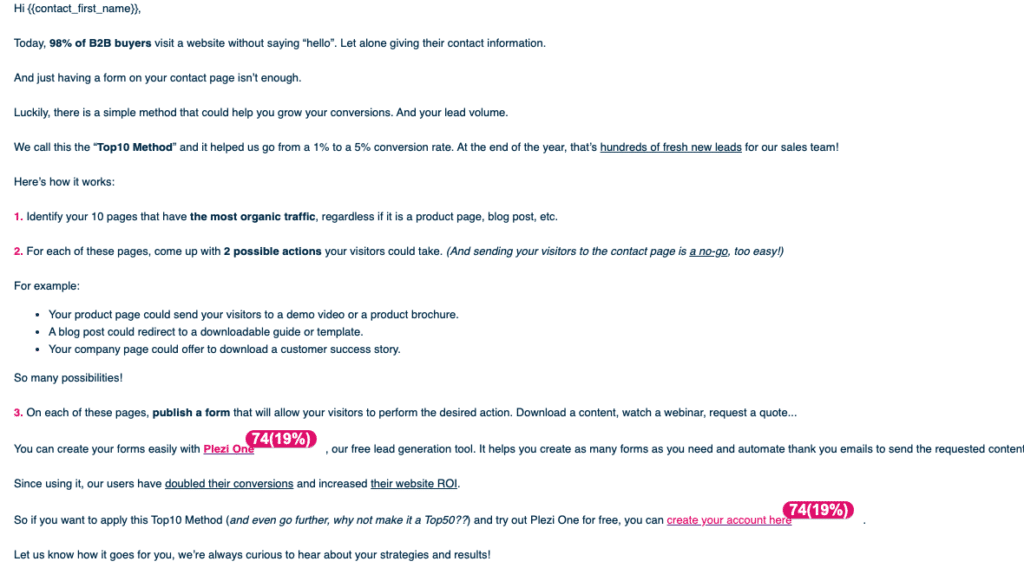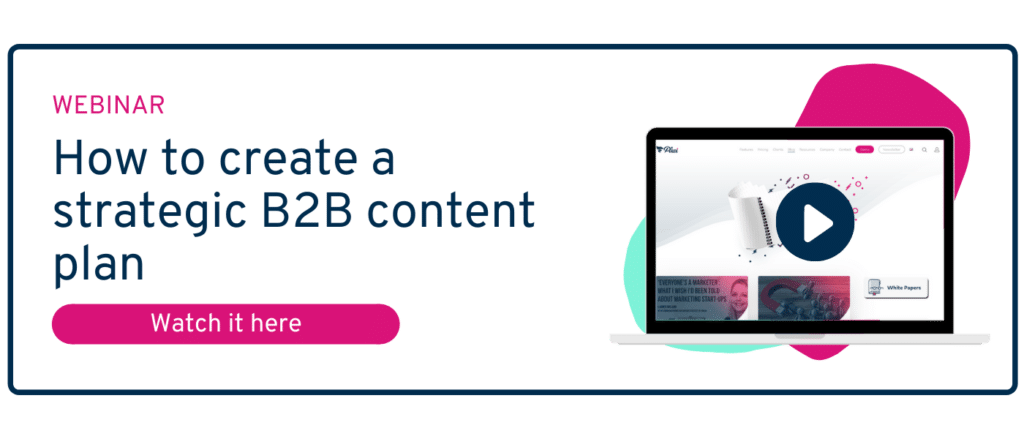Want to become an email marketing expert? To make your email marketing campaign a success, you just need to do three things:
- Make sure your marketing emails are sent to, and received by, the right people
- Do everything you can to ensure that your emails are opened and then read by contacts
- Encourage recipients to take action once they’ve read them
Easy, right? If it doesn’t really seem that way, don’t worry. In the post below, we’ll give you 11 practical tips to make your next email marketing campaign a success.
In this post, we’ll look at:
- What email marketing is, and the different types used
- 1. Keep your contact list up-to-date
- 2. Clearly identify the email sender
- 3. Write a strong subject line
- 4. Work on your preheader
- 5. Choose an effective template design
- 6. Personalize your emails
- 7. Encourage recipients to take action
- 8. Optimize your landing page
- 9. Make sure your campaign displays correctly on all devices
- 10. Send emails at the right time
- 11. Learn from each campaign
- How to optimize your email marketing metrics
What is email marketing?
Email marketing describes all the communications that a company sends to a given target audience (usually leads or customers) by email. These emails are usually sent for the purposes of prospecting, providing information, or as part of a customer loyalty programme.
There are 4 main types of B2B email marketing.
Newsletters
The main purpose of sending email newsletters is to maintain regular contact with leads and customers. They often contain links to your latest blog posts and are a mainstay of any good content marketing strategy.
Sales emails
The purpose of sales emails is to encourage your target audience to purchase your product or service. It’s easy to manage recipients’ consent required by the GDPR when these are used as part of an inbound marketing strategy.
Transactional emails
Unlike other B2B emails which are usually sent to a large group of contacts, transactional emails are automated emails sent from one sender (e.g., an e-commerce website) to a single recipient. They are commonly used in B2B by SaaS platforms.
Automated email marketing
These are email marketing campaigns which look like a personalized email, but which are typically sent to a large group of recipients. They make use of a recipient’s online behavioural data and actions to give emails a degree of personalization and ensure that emails are sent at the right time.
11 tips to run a successful email marketing campaign
Now that we’ve looked at the different types of B2B email marketing, let’s see how emails can be optimized for the best results. Here’s a list of 11 practical tips that you can start using today to make your email marketing campaigns more effective.
1. Keep your contact list up-to-date
An email marketing campaign is much more likely to be successful if emails are sent to the right contacts. That seems obvious, but a quick look at your inbox will probably show you that you receive a lot of emails that you don’t have any real interest in. You should therefore avoid renting or buying email lists, because the contacts they contain are often not at all part of your target audience.
If a contact hasn’t opened any of the last five emails you’ve sent them, some alarm bells should be going off. Obviously, you should try to find out what’s going on. Are they no longer interested in receiving your emails? Have they left their job?
Optimizing an email marketing campaign starts with ensuring that emails are sent to the right people. Marketing automation software lets you continuously update, segment, and target your mailing lists. Most importantly, it lets you ensure GDPR compliance by collecting and automating the management of consents.
Did you know that up to 30% of your contact database can contain inaccurate information in any given year? Yes, you heard right.
But this step is often overlooked. That’s why it’s a good idea to regularly clean your contact database.
2. Clearly identify the email sender
Who am I? Or rather, who am I to the contacts receiving our emails? I could be Adeline Lemercier, Adeline from Plezi, or just Plezi. Are these three the same for the person receiving our emails? Which of these identities will they trust the most?
Changing the identity of the sender of an email can improve your email open rates. Your contacts will only take a few seconds to decide whether or not to open your email. So, if they don’t recognize the sender of your email, it’s game over before you’ve even started.
The perceived identity of the email sender is therefore vitally important. And you’ll increase the chances of a recipient opening an email if it is sent by an individual rather than from a generic company account. The exact form of the sender’s name may vary depending on your sector and where the recipient is in the conversion funnel.
Most SaaS software companies use “first name + company”. In the world of start-up marketing, we typically use first names, while reiterating the name of our company to create an immediate connection with previous interaction with a contact.
But for sending emails to customers at large companies, it can be better to indicate the sender’s first and last names.
3. Write a strong subject line
In a split second your contact has identified that your email is from someone they know. But the battle has not yet been won.
Before a contact opens your email, they’ll want to know the reason why you are contacting them, or the subject of your email. There’s often a fine line between a contact deciding to open your email and delete it. That’s why you again have a split second to convince them to open your email.
There’s no magic formula for writing the ultimate email subject line, but there are a few basic templates you can use:
- A strong promise: your subject line presents your email as providing the solution to a pain point
- A compelling question: your subject line asks a question which the recipient is obliged to answer “yes” to. Need help managing your email marketing campaign? Yes.
- Emotive language: your subject line contains words that arouse strong emotions in the recipient. But be careful not to confuse these with words like “money” or “love” that are likely to fall foul of your contact’s spam filter.
To find out more, check out our 8 tips for writing an email subject line that maximizes your open rate.
4. Work on your preheader
An email preheader is a line of text that appears just after the subject line in many email inboxes. Often, this is a default sentence with a generic message, like “view in browser“.
But guess what? You can also personalize the email preheader. So why not take advantage of this?
In addition to the name of the email sender and the subject line, this is a third piece of information that a recipient can read before deciding to open your email or not. By personalizing this, you have an additional means of convincing a contact to open an email and to improve your email open rate.
5. Choose an effective template design
Optimizing an email marketing campaign also involves finding the ideal balance between form and content. Before a contact even starts reading the text of your email, their first impression of your message is a visual one.
This is why it’s important to choose the right template for your emails. You need to ask yourself what the most suitable design for your email is based on your stated conversion goal.
For an email newsletter, for example, it’s important to strike a balance between text and images that doesn’t overwhelm the reader. For a sales email designed to encourage recipients to take action, it’s better to keep the email simple and to the point and include an email signature with your photo. Whatever template you use, the key to generating engagement is making it look like you’ve personally sent the email to this particular contact.
6. Personalize your emails
Email personalization has become a major focus for all marketing managers. It lets you address the concerns of customers who no longer want to be treated in a standardized way and who want to obtain meaningful answers to the questions they ask.
There’s nothing worse than bombarding your entire mailing list with the same mass email that will probably just make you look like spam. An email should not only use the contact’s first name, content should ideally also touch on past interactions with the contact and justify why you sent the email.
The best way to do this is to use marketing automation software to keep track of interactions with your contacts.
7. Encourage recipients to take action
You don’t create email marketing campaigns just for the fun of it. The main goal of your campaign is to convert contacts. As a result, optimizing an email marketing campaign means encouraging contacts to take action.
The body of your email needs to outline the benefits to your contact of performing the desired action described by your call to action.
Here is a checklist of things that a B2B email should contain:
- A catchy text that focuses on benefits which be structured as follows:
- Statement of a problem or pain point
- Brief presentation of the solution
- The benefits of clicking on the call to action
- A highly-visible and compelling call to action: your recipient won’t waste time trying to find your call to action. Make it clearly visible by minimizing other distractions. You should obviously also avoid using generic phrases like “Click here”.
- Reassuring elements: to help reduce your unsubscribe rate, reassure contacts by highlighting testimonials from customers or key figures.
8. Optimize your landing page
Your email marketing campaign doesn’t just include the emails that you send to contacts. The landing page that contacts are sent to by the call to action is also part of your campaign and a key element in converting them.
Optimizing an email marketing campaign also involves optimizing the dedicated landing page so that it is intuitive for visitors. This starts by making sure that it is responsive, in other words that the web page can be viewed on mobile devices. The graphic design and visual identity of the page should also integrate well with the rest of your website.
9. Make sure your campaign displays correctly on all devices
Like your landing page, the other elements of your email marketing campaign need to be responsive so that they can be viewed on all types of devices, including mobile and tablets.
Most internet users now check their emails using their mobile phone. And any email that is difficult to read will immediately be set aside. Ignoring this trend can result in a lot of lost opportunities.
That’s why it’s a good idea to test how your emails appear on a range of devices before sending them. If you use Plezi, you can quickly see how emails appear on mobile in the email editor.
Also bear in mind that contacts might be viewing your emails using dark mode on their mobile phones. How do your emails appear in dark mode?
10. Send emails at the right time
Deciding on the right time and date to send emails is a key part of your email marketing campaign. But beware of marketing gurus who say that if you send emails on such and such a day, at such and such a time, the stars will align and guarantee success.
The right time to send emails to contacts depends on the nature of your business and your target audience. Obviously, sending emails to B2B contacts on Saturdays at 11pm doesn’t make much sense.
The best way to find the right time is still to test sending emails at different times and track how they perform. If you use Plezi, this is easy to do. All you need to do is go to the reports section for your email marketing campaigns.
11. Learn from each campaign
Once your email marketing campaign is finished, it’s important to analyse the results so you can see what could be improved for the next one.
Here are some important metrics to track:
Bounce rate
The bounce rate indicates the percentage of emails sent that could not be delivered to your contacts. This can either happen because an email address doesn’t exist (a hard bounce) or because the mailbox is full or temporarily unavailable (a soft bounce).
This metric is important to track because it lets you monitor the health of your email list and contact database. A bounce rate that is too high can therefore affect how many emails you can deliver to contacts.
Open rate
The open rate indicates what percentage of emails sent were opened by recipients. This is a good metric to track how well the sender’s name, subject line, and preheader perform.
Click rate
The click rate indicates the percentage of contacts who received your email and who clicked on at least one link in your email. This metric lets you know if your email is sufficiently well designed and written to encourage contacts to take action or to look for further information. To improve your click rate, you need to improve the quality of your writing, your email design, and the visibility of your calls to action.
Unsubscribe rate
The unsubscribe rate indicates the percentage of contacts who receive your email and who unsubscribe from your mailing list. If this figure is too high, it might indicate that you need to think about the quality of content you send contacts, or that you send too many emails to contacts.
How to optimize your email marketing metrics
Optimizing an email marketing campaign actually involves optimizing three different metrics:
- Optimizing the delivery rate, by improving those things which help emails be delivered to contacts. This will be closely tied to your chosen email marketing tool (e.g., using email marketing routing, smtp, and tracking) and your email targeting (opt-in is your friend!).
- Optimizing the open rate, which is mainly influenced by the identity of the sender and the subject line’s use of a strong business message to convince contacts to open the email.
- Optimizing the conversion rate, which is dependent on content, graphic design, and elements that drive conversion.
Each of the tips mentioned above will have an impact on these rates. The most important thing is to make sure you measure the right data.
Email marketing tools (or marketing automation tools) can help significantly with this. They will provide you with all 3 of the above metrics, but also a click map, which is perfect for optimizing the body of an email:
In addition to following some common sense rules that we’ve set down in this post, the process of optimizing your campaign involves a continuous “test and learn” approach. A/B testing and multivariate testing will help you find the most successful format for the emails you send.
By improving how you segment, personalize, and script your B2B email marketing campaigns, marketing automation tools can also greatly increase their effectiveness.
Do you have any other tips for optimizing an email marketing campaign and successfully achieving your marketing goals? Why not tell us in the comments below?







